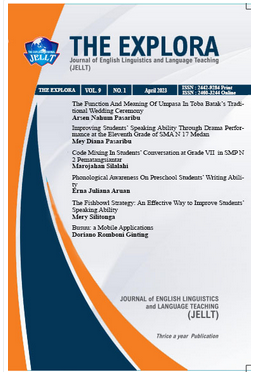Denominal Nominals in Toba Batak: A Generative Transformational Study
Main Article Content
Abstract
The purpose of this article is to elaborate denominal nominalsin Toba Batak language from the view point of generative transformational study. The theory applied in this study is modified theory of Halle‟s model. Therefore, there are six components of sets of generative transformational rules as modified theory in this study, i.e. List of Morphemes, Word Formation Rules, Filter, Orthographic Rules, Phonological Rules, and Dictionary. The data were analysedby applying modified theory with reference to Halle‟s theory as the main theory. The method of this study is descriptive qualitative. The data were collected by using observation and interview. The collected data are voice-recordings and writings. The research findings show that denominalnominals in Toba Batak language are done by attaching (1) prefix [par-], (2) prefix [sa-], (3) infix [-ar-], (4) confix [ha-an], (5) confix[par-an], (6) and affix combination [pasi-]. The resultof the affixation processes generate complex words which have new grammatical and lexical meanings. Phoneme addition takes place in morphological process particularly with prefix [sa-]. The inflectional processes of attaching those affixes bring about phonologicalidiosincracy, therefore, such words must be processed in filter to generate acceptable words in Toba Bataklanguage.
Key Words: Denominal Nominals, Infelctional, Generative Transformational Study.
Downloads
Article Details
References
Ambarita, Esron, (2018a)., Adverbial Derivation in Toba Batak Language: A Generative Transformational Study. Language Literacy: Journal of Linguistics, Literature, and Language Teaching, Volume 2, Number 2. pp. 103-110, December 2018. https://jurnal.uisu.ac.id/index.php/languageliteracy/index
Ambarita, Esron, (2018b)., Nominal Word Formations in Toba Batak Language: A Study of Generative Morphology. The 1stAnnual International Conference on Language and Literature (AICLL),pp. 306-320, https://knepublishing.com/index.php/Kne-Social/article/view/1942/4340
Ambarita, Esron. (2018c)., Adjectival Affixations in Toba Batak Language. A Descriptive Analysis of Adjectives. A Proceeding ofInternational Conference, 5th ELT, Linguistics, Literature, and Translation (ICELLTS), Magister of Education-English Department, Graduate School of HKBP Nommensen University, pages 74-83. https://uhn.ac.id/files/akademik_files/1806060434_2018_The%20Episteme%20Jo urnal%20of%20Linguistics%20and%20Literature%20Vol%204%20No%203_1.%20ADJECTIVAL%20AFFI ATIONS%20IN%20TOBA%20BATAK%20LANGUAGE%20-%20esron.pdf
Ambarita, Esron. (2017a)., DaftarMorfemdalamSistemMorfologiGeneratifBahasaBatak Toba. Jurnal TIFA, Volume 9, Nomor1, EdisiJanuari 2017, ISSN: 2088-7124, Medan: Penerbit Program Pascasarjana S2 PendidikanBahasa Indonesia, Universitas Muslim Nusantara Al Wasliyah, halaman191-207. https://www.researchgate.net/publication/328700406_DAFTAR_MORFEM_DALAM_SISTEM_MORFOLOGI_GENERATIF_BAHASA_BATAK_TOBA
Ambarita, Esron. (2017b)., Denominal Verbs in Toba Batak Language. The Episteme: Journal of Linguistics and Literature, Medan: Published by English Department, Faculty of Language and Arts Nommensen HKBP University, Medan, Indonesia, pages 13-24. https://www.uhn.ac.id/files/akademik_files/1712070859_2017_The%20Episteme%20Journal%20of%20Li nguistics%20and%20Literature%20Vol%203%20No%203_ 2.Esron%20Ambarita%20%2CDenominal%20Verbs%20In%20Toba%20Batak%20Langua ge.pdf
Ambarita, Esron. (2017c)., Morphological Analysis of Adjective Reduplications in Toba Batak Language. Jurnal Penelitian Pendidikan Bahasa dan Sastra, Vol. 2 No. 1 April 2017, ISSN: 2502-9584, Medan: Penerbit Lembaga Penelitian dan Pengabdian Pada Masyarakat Universitas Muslim Nusantara Al Wasliyah, pages 130-137. http://jurnal-p2m.umnaw.ac.id/index.php/cccccc/article/download/157/149/.
Ambarita, Esron. (2016)., Morphological Analysis of Adjectival Affixations in Toba Batak Language. Metholangue: Language Teaching Learning, Linguisticsand Literature, Vol. 1 No. 1, pp. 9-20, ojs.lppmmethodistmedan.educationhttp://ojs.lppmmethodistmedan.net/index.php/METHOLANGUE/article/view/162/.
Anderson, Stephen R. (1982)., Where’s Morphology?.Linguistic Inquiry, Volume 13 Number 4, 571-612Winter, 4(I) I/73(1-108) ISSN 0024-3892.URL: https://www.jstor.org/stable/4178297?origin=JSTOpdf&seq=1.
Aronoff, Mark. (1976)., Word Formation in Generative Grammar. Cambridge: The MIT Press. http://tscheer.free.fr/interface/Aronoff%2076%20Word%20Formation%20in%20Generative%20Grammar.pdf
BIBEL, (2003)., Alkitab dalam Bahasa Batak Toba. Lembaga Alkitab Indonesia, Jakarta.
Chomsky, Noam dan Halle, Morris. (1968)., The Sound Pattern of English. New York: Harper and Row. http://web.mit.edu/morrishalle/pubworks/papers/1968_Chomsky_Halle_TheSound_Pattern_of_English.pdf
Dardjowidjojo, Soenjono. (1988)., MorfologiGeneratif: Teori dan Permasalahan dalam PELLBA I Pertemuan Linguistik Lembaga Bahasa Atma Jaya: Pertama, PenyuntingSoenjonoDardjowidjojo, Jakarta: LembagaBahasaUnikaAtmajaya.
Djajasudarma, T.F. (1993)., Metode Linguistik: Ancangan MetodePenelitian dan Kajian. Bandung: Eresco.Guerssel, Mohand. (1983). A Lexical Approach to Word Formation in English. Linguistic Analysis, Volume 12, Number 3, 183-243, Elsevier Science Publishing, 0098-9053.
Halle, Morris. (1973)., Prolegomena to a Theory of Word Formation. Linguistic Inquiry, Volume 4 Number I, 3-16 Winter, 4(I) I/73 (1-108) ISSN 0024-3892.URL: http://www.jstor.org/stable/4177748.
Jackendoff, Ray. (1975)., Morphological and Semantic Reguralities in the Lexicon. Linguistic Society of America, Language Vol. 51, No. 3, pp. 639-671. URL: http://www.jstor.org/stable/412891.
Lipka, Leonard. (1975)., Prolegomena to Prolegomena to a Theory of Word Formation: A Reply to Morris Halle. Amsterdam Studies in the Theory and History of Linguistic Science IV, Volume 1, 175-184, The Transformational-Generative Paradigm and Modern Linguistic Theory.URL: https://benjamins.com/ catalog/cilt.1.09lip
Loe, Efron Erwin Yohanis. (2018)., Morfologi Bahasa Rote DialekDengka: Kajian Morfologi Generatif. A Dissertation, Doctoral Program of Linguistics, Faculty of Cultural Sciences, Denpasar: University of Udayana. https://www.semanticscholar.org/paper/REDUPLIKASI-BAHASA-ROTE-DIALEK- DENGKA%3A-KAJIAN-Loe-Loe/7afb6538b0e6d7d26fa1432d5e567ee4c068de59
Miles, M. B, Huberman, A. M., & Saldana, J. (2014)., Qualitative Data Analysis: A Methods Sourcebook.3rd Edition. Thousand Oaks: Sage Publications.
Nasution, Khairina. (2011),. Pembentukan Kata dalamBahasa Indonesia yang Berasal dari Bahasa Arab: Kajian Morfologi Generatif. A Dissertation, Doctoral Program of Linguistics, Faculty of Cultural Sciences, Medan: University of Sumatera Utara. http://repository.usu.ac.id /handle/123456789/23992
Samarin, W. J. (1988)., Ilmu Bahasa Lapangan. (Translated by J.S. Badudu from Field Linguistics: A Guide to Linguistic Field Work). Yogyakarta: Kanisius.
Scalise, Sergio. (1984)., Generative Morphology. Dordrecht-Holand/Cinnaminson- USA: Foris Publications.https://books.google.co.id/books/about/Generative_Morphology.html?id=T6f60AwN_OEC&redir_esc=y
Schane, Sanford A. (1973)., Generative Phonology. New Jerssey: Prentice-Hall.
Simpen, I Wayan. (1995)., Afiksasi Verbal Bahasa Bali: Sebuah Kajian Morfologi Generatif. A Master Thesis, Linguistic Study Program, Jakarta: University of Indonesia. https://media.neliti.com/media/ publications/229747-afiksasi-bahasa-bali-sebuah- kajian-morfo-f3a337c3.pdf
Sukri, H. Muhammad. (2008)., Sistem Morfologi Bahasa Sasak Dialek Kuto-Kute: Kajian Transformasi Generatif. A Dissertation, Doctoral Program of Linguistics, Faculty of Cultural Sciences, Denpasar: University of Udayana.
Zainuddin, (2012)., Sistem Morfologi Bahasa Gayo: Kajian Transformasi Generatif. A Dissertation, Doctoral Program of Linguistics, Faculty of Cultural Sciences, Medan: University of Sumatera Utara. https://jurnal.unimed.ac.id/2012/index.php/bahas/article/view/3086/2719
